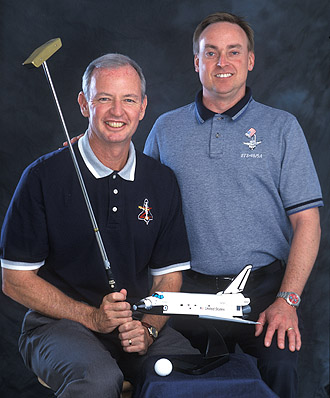The Shuttle Putter And The USGA
By Mike Cullity
On Jan. 11, 1996, the Space Shuttle Endeavour launched from Florida’s Kennedy Space Center with a putter in its payload.
NASA astronaut trainers at Houston’s Johnson Space Center obtained the club as a gift for Brian Duffy, Endeavour’s commander on mission STS-72 and an avid golfer. Manufactured in four detachable pieces that were stowed inside a canvas pouch on board during the nine-day voyage, the mallet-style putter is on display at the USGA Museum.
 |
Retired NASA astronaut Brian Duffy (left) and Tim Terry, flight simulation instructor for United Space Alliance, show off the "Shutle Putter" that was used by Duffy and his crew in space during the 1996 Endeavour voyage (NASA mission STS-72). (John Mummert/USGA) |
Recently, Duffy and Tim Terry, one of the astronaut trainers instrumental in sending the putter into space, were guests at the museum’s Astronaut Day, an event intended to educate children and adults about the U.S. space program while inspiring kids to study science, technology, engineering and mathematics.
“It’s important to let kids know that, hey, they could be part of the space program,” said Duffy, a 56-year-old retired Air Force colonel who flew four shuttle missions. “We share the message of the excitement of space flight.”
Duffy and Terry also enjoy recounting the putter’s story. A pilot on two previous shuttle flights, Duffy was preparing for his first mission as a shuttle commander when his trainers had an idea.
“Several folks knew Brian was an avid golfer and wanted to do something special without him knowing about it,” recalled Terry, a fellow golf devotee and frequent playing partner of Duffy’s.
With the launch approaching, Terry and Brent Jett, the STS-72 pilot, visited Houston clubmaker Mike Gibson, who showed them a prototype putter he had made. Featuring a maple head finished in black with a brass face and soleplate, the putter carried the name “Grim Reaper.”
Examining the putter, Terry and Jett liked it but asked Gibson to make one refinement. “They told me no part could be more than 10 inches long,” Gibson said. “It had to be able to break down.”
Gibson enlisted his friend David Lancaster, a local machinist, to build screwing mechanisms into a stainless-steel shaft that would allow the 31-inch putter to detach into four pieces. And Gibson’s wife, Pat, made a carrying pouch out of sturdy black canvas.
After securing NASA clearance, Jett spirited the Grim Reaper onto Endeavour. On a break during the shuttle’s fourth day in orbit, Jett floated down from the flight deck to retrieve the pouch from a midship locker. Drifting back up, he presented it to Duffy.
“Brett opened the pouch and the handle floated out, followed by the other pieces,” Duffy said. “There was also a Precept ball, which was the brand Tim played. I looked at the side and sure enough, it was imprinted with the initials ‘TJT.’ ”
With the cardboard interior from a spent roll of duct tape, Duffy fashioned a makeshift hole and played low-gravity golf.
“Putting in three dimensions is really kind of interesting,” he said. “You not only miss a putt left or right or long or short, but you can miss one up or down. And technically, you’d always be incurring a two-stroke penalty because you’re always hitting a moving ball.”
Later, as Endeavour flew over Australia, Duffy used the playing implements as props in a photo he staged for one of his golfing heroes, Greg Norman. With the putter and ball floating in the foreground, a crew member snapped Duffy posing in front of a shuttle window overlooking famed Shark Bay while holding a photo of golf’s Great White Shark. Duffy later mounted the photo and gave it to Norman.
Duffy and Terry also created a journey memento for Gibson. “They presented me with a plaque they had made up for ‘taking golf to new heights,’ ” the club designer said.
Along with the Precept ball and canvas pouch, the putter and its headcover reside at the USGA Museum. They join artifacts from astronaut Alan Shepard’s famous 1971 shots on the moon, including the Wilson Staff 6-iron head Shepard used, to commemorate golf’s forays beyond earthly borders.
Mike Cullity is a freelance golf writer. E-mail him with questions or comments at mcullity@gmail.com.
